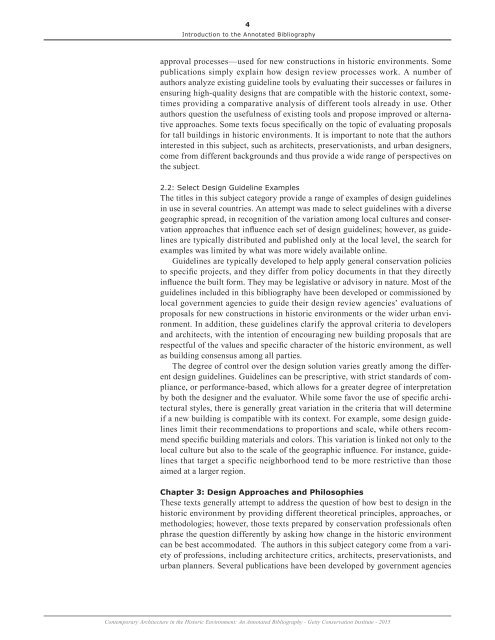Contemporary Architecture in the Historic Environment
cahe_bibliography
cahe_bibliography
You also want an ePaper? Increase the reach of your titles
YUMPU automatically turns print PDFs into web optimized ePapers that Google loves.
4<br />
Introduction to <strong>the</strong> Annotated Bibliography<br />
approval processes—used for new constructions <strong>in</strong> historic environments. Some<br />
publications simply expla<strong>in</strong> how design review processes work. A number of<br />
authors analyze exist<strong>in</strong>g guidel<strong>in</strong>e tools by evaluat<strong>in</strong>g <strong>the</strong>ir successes or failures <strong>in</strong><br />
ensur<strong>in</strong>g high-quality designs that are compatible with <strong>the</strong> historic context, sometimes<br />
provid<strong>in</strong>g a comparative analysis of different tools already <strong>in</strong> use. O<strong>the</strong>r<br />
authors question <strong>the</strong> usefulness of exist<strong>in</strong>g tools and propose improved or alternative<br />
approaches. Some texts focus specifically on <strong>the</strong> topic of evaluat<strong>in</strong>g proposals<br />
for tall build<strong>in</strong>gs <strong>in</strong> historic environments. It is important to note that <strong>the</strong> authors<br />
<strong>in</strong>terested <strong>in</strong> this subject, such as architects, preservationists, and urban designers,<br />
come from different backgrounds and thus provide a wide range of perspectives on<br />
<strong>the</strong> subject.<br />
2.2: Select Design Guidel<strong>in</strong>e Examples<br />
The titles <strong>in</strong> this subject category provide a range of examples of design guidel<strong>in</strong>es<br />
<strong>in</strong> use <strong>in</strong> several countries. An attempt was made to select guidel<strong>in</strong>es with a diverse<br />
geographic spread, <strong>in</strong> recognition of <strong>the</strong> variation among local cultures and conservation<br />
approaches that <strong>in</strong>fluence each set of design guidel<strong>in</strong>es; however, as guidel<strong>in</strong>es<br />
are typically distributed and published only at <strong>the</strong> local level, <strong>the</strong> search for<br />
examples was limited by what was more widely available onl<strong>in</strong>e.<br />
Guidel<strong>in</strong>es are typically developed to help apply general conservation policies<br />
to specific projects, and <strong>the</strong>y differ from policy documents <strong>in</strong> that <strong>the</strong>y directly<br />
<strong>in</strong>fluence <strong>the</strong> built form. They may be legislative or advisory <strong>in</strong> nature. Most of <strong>the</strong><br />
guidel<strong>in</strong>es <strong>in</strong>cluded <strong>in</strong> this bibliography have been developed or commissioned by<br />
local government agencies to guide <strong>the</strong>ir design review agencies’ evaluations of<br />
proposals for new constructions <strong>in</strong> historic environments or <strong>the</strong> wider urban environment.<br />
In addition, <strong>the</strong>se guidel<strong>in</strong>es clarify <strong>the</strong> approval criteria to developers<br />
and architects, with <strong>the</strong> <strong>in</strong>tention of encourag<strong>in</strong>g new build<strong>in</strong>g proposals that are<br />
respectful of <strong>the</strong> values and specific character of <strong>the</strong> historic environment, as well<br />
as build<strong>in</strong>g consensus among all parties.<br />
The degree of control over <strong>the</strong> design solution varies greatly among <strong>the</strong> different<br />
design guidel<strong>in</strong>es. Guidel<strong>in</strong>es can be prescriptive, with strict standards of compliance,<br />
or performance-based, which allows for a greater degree of <strong>in</strong>terpretation<br />
by both <strong>the</strong> designer and <strong>the</strong> evaluator. While some favor <strong>the</strong> use of specific architectural<br />
styles, <strong>the</strong>re is generally great variation <strong>in</strong> <strong>the</strong> criteria that will determ<strong>in</strong>e<br />
if a new build<strong>in</strong>g is compatible with its context. For example, some design guidel<strong>in</strong>es<br />
limit <strong>the</strong>ir recommendations to proportions and scale, while o<strong>the</strong>rs recommend<br />
specific build<strong>in</strong>g materials and colors. This variation is l<strong>in</strong>ked not only to <strong>the</strong><br />
local culture but also to <strong>the</strong> scale of <strong>the</strong> geographic <strong>in</strong>fluence. For <strong>in</strong>stance, guidel<strong>in</strong>es<br />
that target a specific neighborhood tend to be more restrictive than those<br />
aimed at a larger region.<br />
Chapter 3: Design Approaches and Philosophies<br />
These texts generally attempt to address <strong>the</strong> question of how best to design <strong>in</strong> <strong>the</strong><br />
historic environment by provid<strong>in</strong>g different <strong>the</strong>oretical pr<strong>in</strong>ciples, approaches, or<br />
methodologies; however, those texts prepared by conservation professionals often<br />
phrase <strong>the</strong> question differently by ask<strong>in</strong>g how change <strong>in</strong> <strong>the</strong> historic environment<br />
can be best accommodated. The authors <strong>in</strong> this subject category come from a variety<br />
of professions, <strong>in</strong>clud<strong>in</strong>g architecture critics, architects, preservationists, and<br />
urban planners. Several publications have been developed by government agencies<br />
<strong>Contemporary</strong> <strong>Architecture</strong> <strong>in</strong> <strong>the</strong> <strong>Historic</strong> <strong>Environment</strong>: An Annotated Bibliography - Getty Conservation Institute - 2015
















